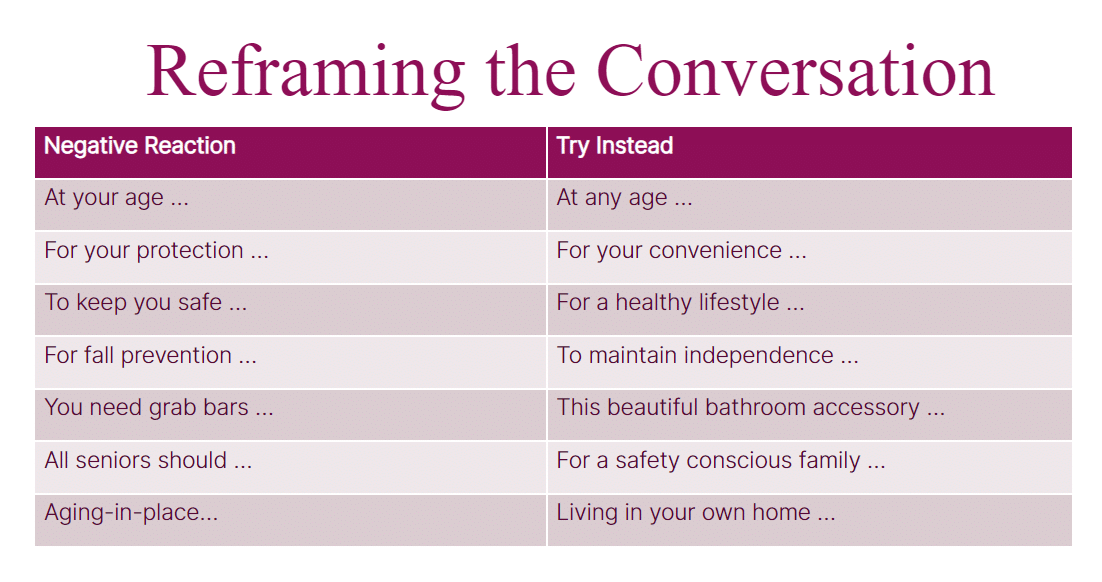Breaking Down Barriers to Fall Prevention with Compassion and Respect
We all know that change can be hard—whether it’s switching up a daily routine or making bigger life adjustments. But for aging parents, change can feel even more overwhelming, especially when it comes to addressing fall prevention in their own home.
If you’re a caregiver, you may have already had difficult conversations with your parents about their safety. Perhaps you’ve suggested installing a grab bar, only to be met with resistance or even outright refusal.
At HealthCraft, we understand how challenging these conversations can be. But we also know that with the right approach, you can help your loved ones take proactive steps to protect their safety, without jeopardizing their dignity or independence.
In this guide, we’ll explore effective strategies for navigating parental resistance to fall prevention, while prioritizing caregiver well-being and maintaining healthy family dynamics.
The Power of Language in Fall Prevention Conversations
When discussing fall prevention, language matters. The words you choose can either help your parents feel empowered and respected, or they can reinforce feelings of vulnerability or loss of independence. To create an open, collaborative conversation, it’s important to use respectful, inclusive language that acknowledges your parents’ autonomy.
Avoid Fear-Based Reasoning
While it might be tempting to share statistics about falls, injuries, and hospitalizations, fear-based reasoning often backfires. Telling your parent that “95% of all hip fractures are caused by falls” may not spark the change you’re hoping for. Instead, it can lead to defensiveness or denial.
What to do instead: Focus on positive outcomes and shared goals. For example, if your parent’s goal is to stay in their home for as long as possible, emphasize how fall prevention measures can help them achieve that goal.
Use Respectful, Empowering Language
Avoid using phrases like “elderly,” “frail,” or “at your age.” These words can feel condescending and may harm your loved one’s self-esteem. Instead, opt for person-first language that puts the focus on their individuality, not their age or perceived limitations.
What to say: Try phrases like, “Let’s find ways to make your home safer, so you can stay independent for longer.” This shifts the focus from age or frailty to a shared goal of independence and safety.
Understanding Risk Tolerance and Motivation for Change
We all have different levels of tolerance for risk. For your parents, the idea of adding safety modifications to their home might feel like an unnecessary overreaction. They might be thinking, “I’ve lived here for decades without an issue—why change now?”
Respect Their Risk Tolerance
One of the keys to a successful conversation is acknowledging that your parent’s tolerance for risk may differ from your own. For example, while you might be hyper-aware of the possible dangers of a slippery bathroom floor, your parents may feel like they can handle it just fine.
What to do: Ask open-ended questions to better understand their perspective. “How do you feel about exploring options to make the bathroom safer?” or “What concerns you most about home safety?” By showing genuine curiosity, you invite them into the conversation instead of directing it.
Motivation for Change
Research shows that people are often more willing to make small adjustments than large-scale changes. For example, your parents may be open to adding non-slip mats in the bathroom but resistant to installing grab bars or starting an exercise routine.
What to do: Start small and build trust. Suggest modest changes first—like removing tripping hazards or improving lighting—then work your way up to bigger modifications. This gradual approach can reduce resistance and make your parents feel more in control of the process.
Collaborating for Change: The Importance of Partnership
Navigating resistance to fall prevention isn’t just about what you say—it’s about how you say it. Collaboration is key to building trust and helping your parents feel empowered rather than pressured.
Motivational Interviewing Techniques
Motivational interviewing is a collaborative communication style that encourages people to reflect on their own motivations for change. By asking open-ended questions and listening actively, you can help your parents identify their own reasons for making safety adjustments.
What to do: Use affirmations to acknowledge their strengths and independence, then reflect back what you hear to show that you’re truly listening. For example, if your parent expresses concern about being a burden, you can say, “It sounds like staying independent is really important to you—let’s work together to make sure you can continue living comfortably in your home.”
Shared Goals
Rather than focusing on what you think is best for your parents, focus on shared goals. For instance, if your parent’s primary goal is to stay in their home, frame the safety conversation in that context. “I know how much you love your home. Let’s make sure it stays comfortable and safe so you can enjoy it for years to come.”
When Cognitive Changes Are a Factor
If your parent is experiencing cognitive changes or dementia, it may be harder for them to engage in meaningful discussions about fall prevention. In these cases, you’ll need to approach the conversation differently.
Involve Family and Caregivers
When reasoning skills are impaired, it’s important to involve others in the decision-making process. This could include other family members, caregivers, or healthcare professionals. Together, you can find ways to gently introduce fall prevention measures without overwhelming your parent.
What to do: Offer to help with the logistics of home safety changes, but keep your parent in the loop. Even if they can’t make decisions independently, involving them in the process helps preserve their dignity.
Self-Care for Caregivers: You Matter, Too
While it’s important to prioritize your parents’ safety, it’s equally crucial to prioritize your own well-being. Navigating resistance can be emotionally draining, and it’s easy to become frustrated or feel like you’re not being heard.
Practice Patience and Compassion
Remember that change is hard for everyone, and it may take time for your parents to come around to the idea of safety modifications. Be patient with yourself and your loved ones, and allow space for reflection between conversations.
Set Boundaries
It’s okay to set boundaries around your caregiving responsibilities. Taking breaks, seeking support from other family members, and practicing self-care can help you maintain your own mental and emotional health.
Navigating Resistance with Respect
Navigating parental resistance to fall prevention isn’t always easy, but with the right language, respect, and a collaborative approach, you can help your loved ones make important changes without compromising their independence or dignity.
At HealthCraft, we’re here to support you every step of the way. Whether you’re looking for advice on how to start the conversation or need help finding the right safety products, we’re here to help you create a safe, comfortable environment for your parents.
Ready to take the next step? Download our Free Home Safety Checklist For Fall Prevention to help start meaningful, respectful conversations today.









